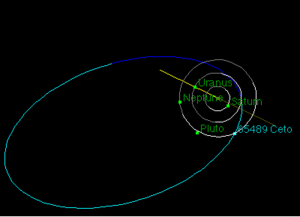65489 Ceto

Orbit (top view)
|
|
| Discovery | |
|---|---|
| Discovered by | C. A. Trujillo and M. Brown |
| Discovery site | Palomar |
| Discovery date | 22 March 2003 |
| Designations | |
| MPC designation | 65489 |
|
Named after
|
Ceto |
| 2003 FX128 | |
|
TNO Centaur–extended |
|
| Adjectives | Cetoean |
| Orbital characteristics | |
| Epoch 13 January 2016 (JD 2457400.5) | |
| Uncertainty parameter 2 | |
| Observation arc | 9239 days (25.30 yr) |
| Aphelion | 187.74 AU (28.086 Tm) |
| Perihelion | 17.8498 AU (2.67029 Tm) |
| 102.79 AU (15.377 Tm) | |
| Eccentricity | 0.82635 |
| 1042.22 yr (380669.7 d) | |
| 9.1219° | |
| 0.00094570°/day | |
| Inclination | 22.266° |
| 171.85° | |
| 320.086° | |
| Known satellites | Phorcys (171±10 ~ 132+6 −14 km in diameter) |
| Earth MOID | 16.895 AU (2.5275 Tm) |
| Jupiter MOID | 12.7433 AU (1.90637 Tm) |
| Physical characteristics | |
| Dimensions |
223±10 km 174+16 −18 km |
| Mass | (5.4±0.4)×1018 kg (system) |
|
Mean density
|
1.37 g/cm3 (system) |
|
Equatorial surface gravity
|
3.3 cm/s2 |
| 4.43 h (0.185 d) | |
|
0.056±0.006 0.084±0.02 |
|
| 6.54±0.06, 6.4 | |
65489 Ceto /ˈsiːtoʊ/ is a binary trans-Neptunian object (TNO) discovered on March 22, 2003 by C. A. Trujillo and M. Brown at Palomar. It is named after the sea goddess Ceto from Greek mythology. The object was identified as a binary on April 11, 2006 by K. Noll, H. Levison, W. Grundy and D. Stephens using the Hubble Space Telescope; the companion object is named Phorcys (/ˈfɔərsᵻs/, formally (65849) Ceto I Phorcys), after the Greek sea god. Using an extended definition of a centaur as an object on a non-resonant (unstable) orbit with its perihelion inside the orbit of Neptune, the Ceto system can be considered the second known binary centaur. It came to perihelion in 1989.
65489 Ceto is an example of a close binary TNO system in which the components are of similar size. Combined observations with the infrared Spitzer Space Telescope and the Hubble Telescope allow the diameter of Ceto itself to be estimated at 174+16
−18 km and the diameter of Phorcys at 132+6
−14 km, assuming equal albedo for both components.
...
Wikipedia
